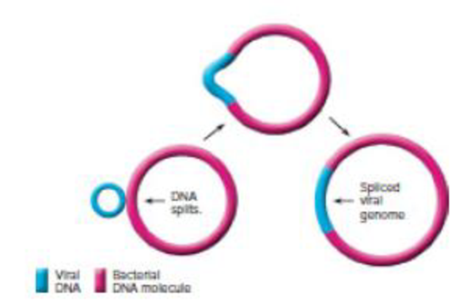
Microbiology: A Systems Approach
4th Edition
ISBN: 9780073402437
Author: Marjorie Kelly Cowan Professor
Publisher: McGraw-Hill Education
expand_more
expand_more
format_list_bulleted
Concept explainers
Textbook Question
Chapter 10, Problem 1VC
From chapter 6, figure 6.19. What has happened to the bacterial DNA in this illustration? What effect can this have on a bacterium? Is this temporary permanent?

Expert Solution & Answer
Want to see the full answer?
Check out a sample textbook solution
Students have asked these similar questions
Explain in a small summary how:
What genetic information can be obtained from a Punnet square? What genetic information cannot be determined from a Punnet square?
Why might a Punnet Square be beneficial to understanding genetics/inheritance?
In a small summary write down:
Not part of a graded assignment, from a past midterm
Chapter 10 Solutions
Microbiology: A Systems Approach
Ch. 10.1 - Provide examples of practical applications of...Ch. 10.2 - Prob. 2AYPCh. 10.2 - Describe how gel electrophoresis is used to...Ch. 10.2 - Prob. 4AYPCh. 10.2 - Prob. 5AYPCh. 10.3 - Prob. 6AYPCh. 10.3 - List examples of genetically modified bacteria,...Ch. 10.4 - Prob. 8AYPCh. 10.4 - Prob. 9AYPCh. 10.5 - Prob. 2CF
Ch. 10.5 - Outline in general terms the process of DNA...Ch. 10.5 - Prob. 11AYPCh. 10.5 - Prob. 12AYPCh. 10.5 - Prob. 13AYPCh. 10.6 - Prob. 14AYPCh. 10 - Prob. 1CFCh. 10 - Which of the following is/are not essential to...Ch. 10 - Prob. 2MCQCh. 10 - The function of ligase is to a. rejoin segments of...Ch. 10 - The creation of biological molecules entirely from...Ch. 10 - Which of the following sequences, when combined...Ch. 10 - A region of DNA in a plasmid that is recognized by...Ch. 10 - Prob. 7MCQCh. 10 - Which of the following is a primary participant in...Ch. 10 - Single nucleotide polymorphisms are found in a....Ch. 10 - Microarrays are used to monitor a. the rate of DNA...Ch. 10 - Prob. 11TFCh. 10 - A nucleic acid probe can be used to identify...Ch. 10 - Prob. 13TFCh. 10 - In order to detect recombinant cells, plasmids...Ch. 10 - Plasmids are the only vectors currently available...Ch. 10 - You are a public health official trying to...Ch. 10 - a.Construct a strand of complementary DNA (cDNA)...Ch. 10 - Prob. 3CTQCh. 10 - Prob. 4CTQCh. 10 - Prob. 5CTQCh. 10 - Prob. 6CTQCh. 10 - a.Define the term RFLP. Explain how RFLPs are...Ch. 10 - Prob. 8CTQCh. 10 - Prob. 9CTQCh. 10 - Prob. 10CTQCh. 10 - Prob. 1CCCh. 10 - Prob. 2CCCh. 10 - Prob. 3CCCh. 10 - Prob. 4CCCh. 10 - From chapter 6, figure 6.19. What has happened to...Ch. 10 - Prob. 2VCCh. 10 - Using the words that follow, please create a...
Knowledge Booster
Learn more about
Need a deep-dive on the concept behind this application? Look no further. Learn more about this topic, biology and related others by exploring similar questions and additional content below.Similar questions
- Noggin mutation: The mouse, one of the phenotypic consequences of Noggin mutationis mispatterning of the spinal cord, in the posterior region of the mouse embryo, suchthat in the hindlimb region the more ventral fates are lost, and the dorsal Pax3 domain isexpanded. (this experiment is not in the lectures).a. Hypothesis for why: What would be your hypothesis for why the ventral fatesare lost and dorsal fates expanded? Include in your answer the words notochord,BMP, SHH and either (or both of) surface ectoderm or lateral plate mesodermarrow_forwardNot part of a graded assignment, from a past midtermarrow_forwardNot part of a graded assignment, from a past midtermarrow_forward
- please helparrow_forwardWhat does the heavy dark line along collecting duct tell us about water reabsorption in this individual at this time? What does the heavy dark line along collecting duct tell us about ADH secretion in this individual at this time?arrow_forwardBiology grade 10 study guidearrow_forward
arrow_back_ios
SEE MORE QUESTIONS
arrow_forward_ios
Recommended textbooks for you
 Biology Today and Tomorrow without Physiology (Mi...BiologyISBN:9781305117396Author:Cecie Starr, Christine Evers, Lisa StarrPublisher:Cengage Learning
Biology Today and Tomorrow without Physiology (Mi...BiologyISBN:9781305117396Author:Cecie Starr, Christine Evers, Lisa StarrPublisher:Cengage Learning Biology 2eBiologyISBN:9781947172517Author:Matthew Douglas, Jung Choi, Mary Ann ClarkPublisher:OpenStax
Biology 2eBiologyISBN:9781947172517Author:Matthew Douglas, Jung Choi, Mary Ann ClarkPublisher:OpenStax Biology: The Unity and Diversity of Life (MindTap...BiologyISBN:9781305073951Author:Cecie Starr, Ralph Taggart, Christine Evers, Lisa StarrPublisher:Cengage Learning
Biology: The Unity and Diversity of Life (MindTap...BiologyISBN:9781305073951Author:Cecie Starr, Ralph Taggart, Christine Evers, Lisa StarrPublisher:Cengage Learning Biology: The Dynamic Science (MindTap Course List)BiologyISBN:9781305389892Author:Peter J. Russell, Paul E. Hertz, Beverly McMillanPublisher:Cengage Learning
Biology: The Dynamic Science (MindTap Course List)BiologyISBN:9781305389892Author:Peter J. Russell, Paul E. Hertz, Beverly McMillanPublisher:Cengage Learning Human Heredity: Principles and Issues (MindTap Co...BiologyISBN:9781305251052Author:Michael CummingsPublisher:Cengage Learning
Human Heredity: Principles and Issues (MindTap Co...BiologyISBN:9781305251052Author:Michael CummingsPublisher:Cengage Learning

Biology Today and Tomorrow without Physiology (Mi...
Biology
ISBN:9781305117396
Author:Cecie Starr, Christine Evers, Lisa Starr
Publisher:Cengage Learning

Biology 2e
Biology
ISBN:9781947172517
Author:Matthew Douglas, Jung Choi, Mary Ann Clark
Publisher:OpenStax

Biology: The Unity and Diversity of Life (MindTap...
Biology
ISBN:9781305073951
Author:Cecie Starr, Ralph Taggart, Christine Evers, Lisa Starr
Publisher:Cengage Learning


Biology: The Dynamic Science (MindTap Course List)
Biology
ISBN:9781305389892
Author:Peter J. Russell, Paul E. Hertz, Beverly McMillan
Publisher:Cengage Learning

Human Heredity: Principles and Issues (MindTap Co...
Biology
ISBN:9781305251052
Author:Michael Cummings
Publisher:Cengage Learning
genetic recombination strategies of bacteria CONJUGATION, TRANSDUCTION AND TRANSFORMATION; Author: Scientist Cindy;https://www.youtube.com/watch?v=_Va8FZJEl9A;License: Standard youtube license